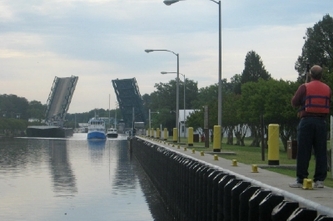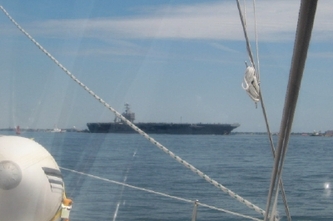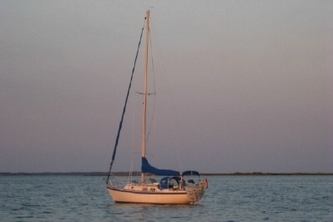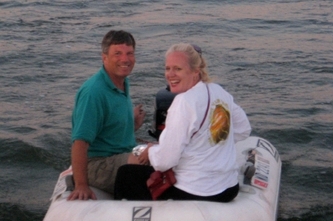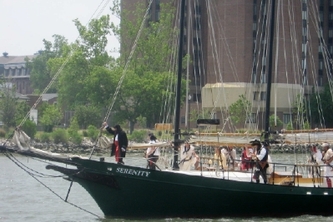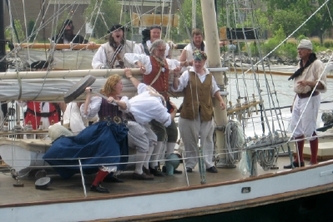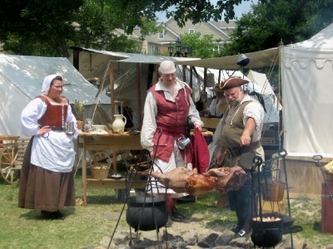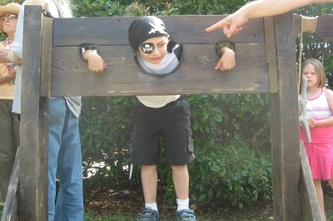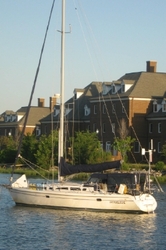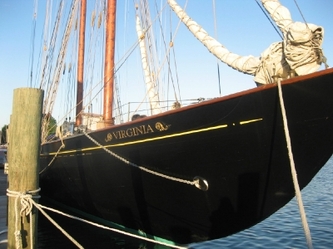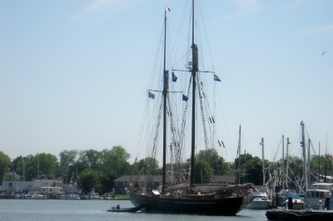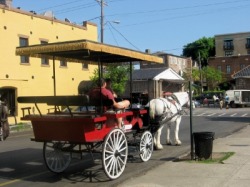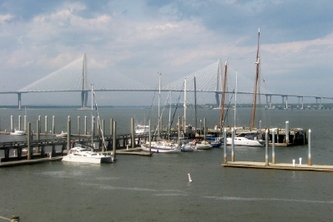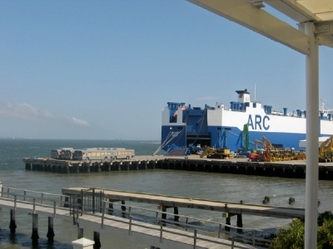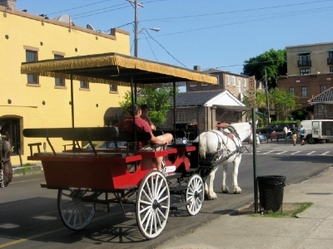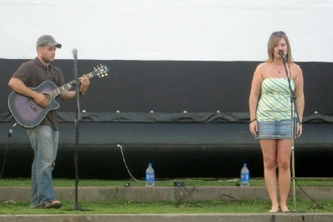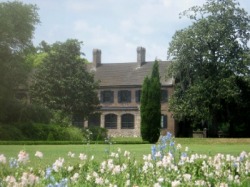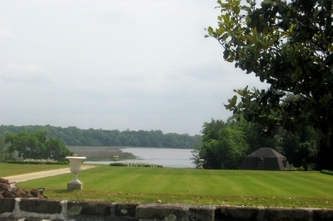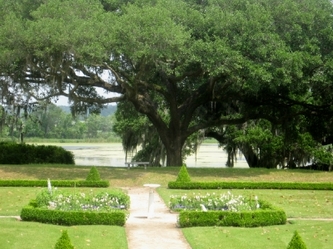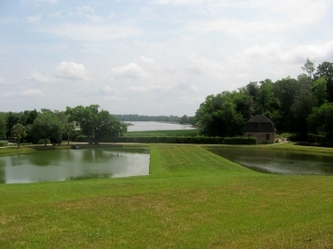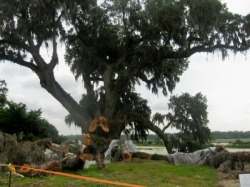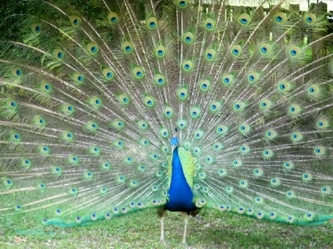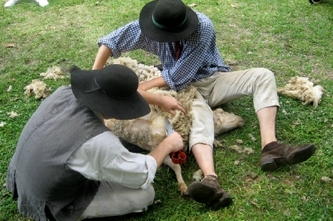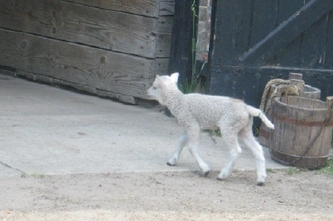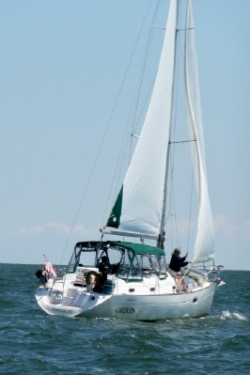
Despite our intentions to make a leisurely trip north from Charleston to Hampton, we made it north in record time. It seemed every time we tried to slow down and take it easy, circumstances prevailed to push us on. So, we’ve enjoyed the extra time here in southern VA, working on the boat, seeing friends and family.
South River to Alligator River
At the end of last update, we were going to take some time out in the South River, opposite Oriental, NC. That changed when we thought we saw the perfect opportunity for some sailing in the Neuse River on Saturday, May 17. We decided to make a short day of it and travel only 12 miles to an anchorage in Bear Creek, off the Bay River, just before the ICW enters the Hobucken cut.
Unfortunately, as usually happens for sailors, the winds did not cooperate. As we tried to set our sails upon leaving the South River, the wind promptly evaporated. We kept motoring on, hoping for a wind shift, which didn’t happen -- that is, until it was too late to take advantage of it. It did, however, arrive in time to fan the flames of a huge brush fire in the marshes north of us as we headed into the Bay River. The smoke quickly filled the air for miles and created the only clouds in an otherwise perfectly clear blue sky. We immediately reported the fire to the Coast Guard, only to learn later that this was a “controlled burn”. We never learned why there was a need for such devastation.
South River to Alligator River
At the end of last update, we were going to take some time out in the South River, opposite Oriental, NC. That changed when we thought we saw the perfect opportunity for some sailing in the Neuse River on Saturday, May 17. We decided to make a short day of it and travel only 12 miles to an anchorage in Bear Creek, off the Bay River, just before the ICW enters the Hobucken cut.
Unfortunately, as usually happens for sailors, the winds did not cooperate. As we tried to set our sails upon leaving the South River, the wind promptly evaporated. We kept motoring on, hoping for a wind shift, which didn’t happen -- that is, until it was too late to take advantage of it. It did, however, arrive in time to fan the flames of a huge brush fire in the marshes north of us as we headed into the Bay River. The smoke quickly filled the air for miles and created the only clouds in an otherwise perfectly clear blue sky. We immediately reported the fire to the Coast Guard, only to learn later that this was a “controlled burn”. We never learned why there was a need for such devastation.
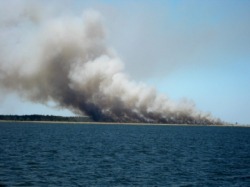
Brush fires north of Oriental
With no wind to make for good sailing, and stormy weather headed our way the next day, we decided to continue on through Hobucken Cut, across the Pamlico and Pungo Rivers and anchor for a couple of days in Slade Creek, opposite Belhaven. We had anchored there a couple of years ago, and it seemed to have lots of space and good holding.
So, 37 miles and 6 hours after starting out for a short sail, we were anchored in Slade Creek and planned to stay put for a couple of nights.
So, 37 miles and 6 hours after starting out for a short sail, we were anchored in Slade Creek and planned to stay put for a couple of nights.
This is your new blog post. Click here and start typing, or drag in elements from the top bar.
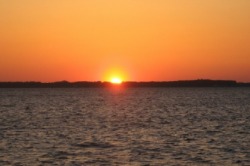
We can't be dragging
When we decide to anchor out, we use our GPS anchor alarm to give us an audible alarm if Orion drifts outside a set perimeter around the anchor. This generally works well, but every now and then, our GPS loses “accuracy” and causes a false anchor drag alarm. Since we haven’t drug anchor in a couple of years, we assumed this was the case in Slade Creek, when the alarm sounded on Sunday afternoon. We had been anchored for about 18 hours, so even though we were just starting to feel some stronger wind gusts, it didn’t seem probable that we could be dragging.
However, as Dave checked the instruments to see how strong the winds were, the anchor alarm sounded. He started looking at the GPS and the few landmarks around us. (There weren’t many.) It didn’t take long to determine that this was no false alarm. We were dragging, and the crab floats that had been so far away last night were getting closer. We were going to have to pull the anchor and move. Now.
Cathy started the engine, and Dave moved forward to the bow to pull the anchor. The winds were 35 knots and gusting higher. Not ideal weather for pulling anchor. Cathy tried to keep the engine engaged enough to reduce the strain on the anchor and keep Orion away from crab pots and off the nearby shoal extending from the north shore. Dave managed to get the anchor on board, and Cathy began plowing into what had become 2-3 foot seas with waves crashing over the bow. (She was thanking her lucky stars that she had closed the portlights below only minutes before the anchor alarm went off.)
As we took turns at the helm, we took care of stowing things below and getting our normal “pre-departure” checklist items taken care of. At one point, we heard an awful clanking noise, causing Cathy to spring up from below. We had snagged a crab pot. With the winds still above 30 knots and blowing us toward shore, we couldn’t afford to be paralyzed by a crab line around the prop. Dave quickly put the engine into neutral and then reverse, and was able to spin the pot off. We were getting spooked. We had successfully navigated thousands of crab pots in 3 years since we started sailing on Orion. It seemed incredible that we could drag anchor and snag a crab pot for the first time within minutes of each other.
And now, we were slogging our way up the Pungo River, motorsailing in high winds and seas. So, where would we go? Docking somewhere in this wind seemed out of the question. We knew of only 2 anchorages with enough room to allow us room to weather the storm. The first was only 12 miles away. The 2nd was 35 miles away. Having left the anchorage at 1pm, we wouldn’t make the further anchorage until after 7pm. But we had held there in higher winds, so that seemed to be the better choice. As we passed the anchorage in the Pungo River just before the 20 mile Alligator-Pungo Canal, it already had 4 boats anchored there. Although we hadn’t explored all the way up the channel to know if there might be enough room further up, we decided to press on to the Alligator River. It was a huge anchorage, holding was good, and protection could be found from the southwest, where the winds were coming from.
We motored by ourselves through the canal, which was protected from the high winds. The 3 boats that were with us in the Pungo River had quickly found shelter. The wind-driven current gave our speed a boost, so we made it to the anchorage on the Alligator River earlier than expected, although the wind speeds increased as expected after we left the canal. We chose a spot favoring the southwest shore and anchored successfully on the first try.
But the day wasn’t over yet. NOAA weather was warning of severe storms moving through the area, including some tornado warnings. Cathy quickly fixed dinner, which we gulped down and had almost cleaned up when Dave said, “It’s here.” Cathy came up to join him in the cockpit, and we started the engine. Orion swung to the northwest in the direction of the first of the 2 storms. The wind gusts were as high as 46 knots and the first storm passed just north of us, but the anchor held. That gave us more confidence for the 2nd storm, which passed right over us. Luckily, we had wind and rain only – no lightning. The storms passed within an hour, and the rest of the night was quiet.
So much for a relaxing Sunday at anchor.
A Forecast Gone Wrong
In listening to the forecast for the upcoming week, it became clear that we wanted to be someplace secure on Tuesday, as severe storms were due to pass through in advance of a cold front. However, Monday was supposed to be a good day to travel – west winds 10 to 15 knots. Not a bad day to cross the Albemarle Sound. We left the anchorage early to make our way up the Alligator River toward the sound and Coinjock on the other side.
The winds were good for sailing, so we killed the engine and sailed up the river, making the Alligator River swing bridge by 10am. However, we were disturbed by conflicting reports of the conditions on the sound. More than one boat that headed out from the Alligator River Marina had turned around and come back, including a sailboat, which usually can tolerate wind and waves better than trawlers. We took a chance and called Restless, who we believed was only a day ahead of us. Sure enough, they answered after having just crossed the sound. Their report was disturbing – 5 foot seas, winds above 25 knots from the northwest. As we were considering our options for going forward or staying at the Alligator River Marina, we heard a report from another sailboat, Star. Apparently, conditions had changed dramatically since Restless crossed. Star was having a lovely sail, wind only 18 knots, best sailing they’d had in months.
Hmm. . .
We decided to press on. The forecast was for the winds to diminish over the course of the day, maybe they had already started. As we stuck our nose out into the Albemarle Sound, it became obvious that conditions had not gotten better at all. We managed to sail again, but the waves were as high as we’ve seen on the sound and the wind was 30 knots gusting to 35 from the Northwest. Where were those 10 to 15 knot West winds? There were others out there with us, so we decided to keep going. We were just a little past halfway across the Albemarle when the first crab float appeared. With the waves as high as they were, it was going to be hard to spot them, so one of us had to remain constantly on watch, while the other was at the helm.
As we neared the North River on the other side, the floats got thicker and were indiscriminately strung across the channel. We could no longer sail around them as the channel narrowed. We needed to start the engine. However, Cathy discovered a raw water strainer half full of water when she went to start it. She took the helm while Dave tried to re-fill it in the rough conditions. He was partially successful, so we cranked her up, but kept the rpm’s low to prevent any further water loss. The winds continued to howl as we headed up the wide mouth of the river, but eventually the waves started to moderate. We continued motorsailing to Coinjock, getting a 35 knot gust just before docking there.
When we decide to anchor out, we use our GPS anchor alarm to give us an audible alarm if Orion drifts outside a set perimeter around the anchor. This generally works well, but every now and then, our GPS loses “accuracy” and causes a false anchor drag alarm. Since we haven’t drug anchor in a couple of years, we assumed this was the case in Slade Creek, when the alarm sounded on Sunday afternoon. We had been anchored for about 18 hours, so even though we were just starting to feel some stronger wind gusts, it didn’t seem probable that we could be dragging.
However, as Dave checked the instruments to see how strong the winds were, the anchor alarm sounded. He started looking at the GPS and the few landmarks around us. (There weren’t many.) It didn’t take long to determine that this was no false alarm. We were dragging, and the crab floats that had been so far away last night were getting closer. We were going to have to pull the anchor and move. Now.
Cathy started the engine, and Dave moved forward to the bow to pull the anchor. The winds were 35 knots and gusting higher. Not ideal weather for pulling anchor. Cathy tried to keep the engine engaged enough to reduce the strain on the anchor and keep Orion away from crab pots and off the nearby shoal extending from the north shore. Dave managed to get the anchor on board, and Cathy began plowing into what had become 2-3 foot seas with waves crashing over the bow. (She was thanking her lucky stars that she had closed the portlights below only minutes before the anchor alarm went off.)
As we took turns at the helm, we took care of stowing things below and getting our normal “pre-departure” checklist items taken care of. At one point, we heard an awful clanking noise, causing Cathy to spring up from below. We had snagged a crab pot. With the winds still above 30 knots and blowing us toward shore, we couldn’t afford to be paralyzed by a crab line around the prop. Dave quickly put the engine into neutral and then reverse, and was able to spin the pot off. We were getting spooked. We had successfully navigated thousands of crab pots in 3 years since we started sailing on Orion. It seemed incredible that we could drag anchor and snag a crab pot for the first time within minutes of each other.
And now, we were slogging our way up the Pungo River, motorsailing in high winds and seas. So, where would we go? Docking somewhere in this wind seemed out of the question. We knew of only 2 anchorages with enough room to allow us room to weather the storm. The first was only 12 miles away. The 2nd was 35 miles away. Having left the anchorage at 1pm, we wouldn’t make the further anchorage until after 7pm. But we had held there in higher winds, so that seemed to be the better choice. As we passed the anchorage in the Pungo River just before the 20 mile Alligator-Pungo Canal, it already had 4 boats anchored there. Although we hadn’t explored all the way up the channel to know if there might be enough room further up, we decided to press on to the Alligator River. It was a huge anchorage, holding was good, and protection could be found from the southwest, where the winds were coming from.
We motored by ourselves through the canal, which was protected from the high winds. The 3 boats that were with us in the Pungo River had quickly found shelter. The wind-driven current gave our speed a boost, so we made it to the anchorage on the Alligator River earlier than expected, although the wind speeds increased as expected after we left the canal. We chose a spot favoring the southwest shore and anchored successfully on the first try.
But the day wasn’t over yet. NOAA weather was warning of severe storms moving through the area, including some tornado warnings. Cathy quickly fixed dinner, which we gulped down and had almost cleaned up when Dave said, “It’s here.” Cathy came up to join him in the cockpit, and we started the engine. Orion swung to the northwest in the direction of the first of the 2 storms. The wind gusts were as high as 46 knots and the first storm passed just north of us, but the anchor held. That gave us more confidence for the 2nd storm, which passed right over us. Luckily, we had wind and rain only – no lightning. The storms passed within an hour, and the rest of the night was quiet.
So much for a relaxing Sunday at anchor.
A Forecast Gone Wrong
In listening to the forecast for the upcoming week, it became clear that we wanted to be someplace secure on Tuesday, as severe storms were due to pass through in advance of a cold front. However, Monday was supposed to be a good day to travel – west winds 10 to 15 knots. Not a bad day to cross the Albemarle Sound. We left the anchorage early to make our way up the Alligator River toward the sound and Coinjock on the other side.
The winds were good for sailing, so we killed the engine and sailed up the river, making the Alligator River swing bridge by 10am. However, we were disturbed by conflicting reports of the conditions on the sound. More than one boat that headed out from the Alligator River Marina had turned around and come back, including a sailboat, which usually can tolerate wind and waves better than trawlers. We took a chance and called Restless, who we believed was only a day ahead of us. Sure enough, they answered after having just crossed the sound. Their report was disturbing – 5 foot seas, winds above 25 knots from the northwest. As we were considering our options for going forward or staying at the Alligator River Marina, we heard a report from another sailboat, Star. Apparently, conditions had changed dramatically since Restless crossed. Star was having a lovely sail, wind only 18 knots, best sailing they’d had in months.
Hmm. . .
We decided to press on. The forecast was for the winds to diminish over the course of the day, maybe they had already started. As we stuck our nose out into the Albemarle Sound, it became obvious that conditions had not gotten better at all. We managed to sail again, but the waves were as high as we’ve seen on the sound and the wind was 30 knots gusting to 35 from the Northwest. Where were those 10 to 15 knot West winds? There were others out there with us, so we decided to keep going. We were just a little past halfway across the Albemarle when the first crab float appeared. With the waves as high as they were, it was going to be hard to spot them, so one of us had to remain constantly on watch, while the other was at the helm.
As we neared the North River on the other side, the floats got thicker and were indiscriminately strung across the channel. We could no longer sail around them as the channel narrowed. We needed to start the engine. However, Cathy discovered a raw water strainer half full of water when she went to start it. She took the helm while Dave tried to re-fill it in the rough conditions. He was partially successful, so we cranked her up, but kept the rpm’s low to prevent any further water loss. The winds continued to howl as we headed up the wide mouth of the river, but eventually the waves started to moderate. We continued motorsailing to Coinjock, getting a 35 knot gust just before docking there.
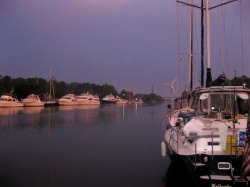
We were glad to tie up, and we weren’t the only ones. Only 2 of the 10 sailboats that docked in Coinjock that night moved on the next morning. We were all beat, and had no interest in braving another wicked weather day, with forecasts of severe thunderstorms and tornado warnings. That dock looked pretty good to us.
We spent our extra day taking a walk (we hadn’t been on land in a week), catching up on mail and other internet business, doing laundry, etc. When the storms rolled through as expected, our decision was easily justified.
We spent our extra day taking a walk (we hadn’t been on land in a week), catching up on mail and other internet business, doing laundry, etc. When the storms rolled through as expected, our decision was easily justified.
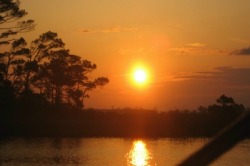
Sunrise north of Coinjock
Coinjock to Great Bridge
With all the sailboats in Coinjock, we decided to leave as early as possible to make the free dock at Great Bridge before the possible competition. We were up and underway before sunrise, and docked north of the Great Bridge bridge by noon, even after losing time waiting for 2 of the 3 opening bridge’s scheduled openings.
Great Bridge is a convenient stop for boaters, with a grocery store, pharmacy, propane, restaurants, and even a Dairy Queen a short walk from the dock. While we were there, some boats docked just for an hour or 2 to go to dinner ashore and then head on. We took advantage of the many services on shore and spent some time getting to know our neighbors on the dock.
We were now only a short trip to Hampton, but we had a problem. Marianna was in our slip at Joy’s Marina. (Well, it wasn’t exactly our slip, but we had grown accustomed to it, since we stayed in it last summer and fall.) Lucky for us, Fred had arrived in Hampton the day before we made it to Great Bridge. He was preparing to move Marianna north, and had recruited a volunteer crew, Julie, to help him make the trip. They came to visit us in Great Bridge before heading out the next morning (Thursday, May 22). It was great to see them.
We also appreciated the residual effect of getting our slip back.
With all the sailboats in Coinjock, we decided to leave as early as possible to make the free dock at Great Bridge before the possible competition. We were up and underway before sunrise, and docked north of the Great Bridge bridge by noon, even after losing time waiting for 2 of the 3 opening bridge’s scheduled openings.
Great Bridge is a convenient stop for boaters, with a grocery store, pharmacy, propane, restaurants, and even a Dairy Queen a short walk from the dock. While we were there, some boats docked just for an hour or 2 to go to dinner ashore and then head on. We took advantage of the many services on shore and spent some time getting to know our neighbors on the dock.
We were now only a short trip to Hampton, but we had a problem. Marianna was in our slip at Joy’s Marina. (Well, it wasn’t exactly our slip, but we had grown accustomed to it, since we stayed in it last summer and fall.) Lucky for us, Fred had arrived in Hampton the day before we made it to Great Bridge. He was preparing to move Marianna north, and had recruited a volunteer crew, Julie, to help him make the trip. They came to visit us in Great Bridge before heading out the next morning (Thursday, May 22). It was great to see them.
We also appreciated the residual effect of getting our slip back.
We headed out Friday morning for Hampton, clearing the lock at 8am and making it to our slip by 1pm. It was a mostly uneventful trip, except for dodging that aircraft carrier, docking in front of us. (There was that repeated warning about use of “deadly force” if you get closer than 500 yards, that motivates you to communicate with the escort boat to ensure we are not too close.) As an interesting coincidence, it was the same ship involved in “live fire exercises” off Beaufort as we headed in after our trip from Charleston.
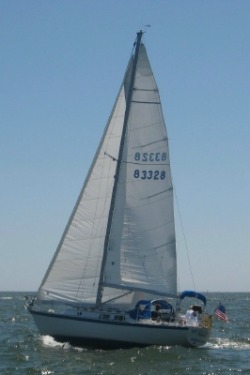
Memorial Day with Bay Dreamer
Our arrival in Hampton coincided with Memorial Day weekend, which gave us the opportunity to join Steve and Krista on Bay Dreamer (our neighbors at Joy’s Marina) for a weekend in Mobjack Bay. As these things go, we were headed north into the wind on Saturday morning and south into the wind on Monday as we returned. Typical. We still got some sailing in (more on the return than on the trip up). With our raw water problems worse in higher seas, we were glad to be able to sail as much as we did. We also enjoyed a couple of nights anchoring in the Severn River (off Mobjack, not the one by Annapolis), over a perfect weekend.
We provided ferry service in our dinghy, but we were surprised that our reliable motor kept sputtering off. Dave decided to drain the gas and refill and the problems disappeared.
Our arrival in Hampton coincided with Memorial Day weekend, which gave us the opportunity to join Steve and Krista on Bay Dreamer (our neighbors at Joy’s Marina) for a weekend in Mobjack Bay. As these things go, we were headed north into the wind on Saturday morning and south into the wind on Monday as we returned. Typical. We still got some sailing in (more on the return than on the trip up). With our raw water problems worse in higher seas, we were glad to be able to sail as much as we did. We also enjoyed a couple of nights anchoring in the Severn River (off Mobjack, not the one by Annapolis), over a perfect weekend.
We provided ferry service in our dinghy, but we were surprised that our reliable motor kept sputtering off. Dave decided to drain the gas and refill and the problems disappeared.
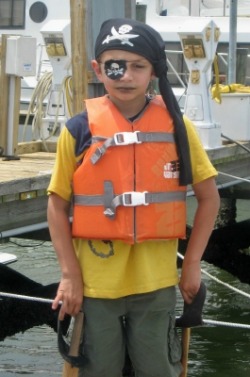
The Pirates are Back!
One of the advantages of our early arrival in Hampton was that we would be there for the Blackbeard Pirate Festival. With our oldest grandson here for a visit, we saw pirates take over merchant ships, get overtaken by the British, and chased with women wielding frying pans. There was also a pirate encampment, and numerous battles by miniature pirates with swords (our grandson included).
One of the advantages of our early arrival in Hampton was that we would be there for the Blackbeard Pirate Festival. With our oldest grandson here for a visit, we saw pirates take over merchant ships, get overtaken by the British, and chased with women wielding frying pans. There was also a pirate encampment, and numerous battles by miniature pirates with swords (our grandson included).
Although Saturday’s high winds cancelled the fireworks, we joined Steve and Krista, her boys, Tom and Cathie from Interlude and the others on the docks at Joy’s Marina for a fun cookout as Saturday’s festival ended. On Sunday, we were joined by our son Adam, our grandson Jayden, his friend Kristina and her daughter Alexis for lunch and a shorter day at the festival. We then collapsed in a heap, grateful for a rest. It had been a long weekend.
Boat and other Stuff
Cathy took advantage of the unseasonably cool weather to apply Cetol to most of the exterior woodwork (the gunwales, toerails, side steps), getting 4 coats in time for the Pirate Festival. Dave decided to use our access to a dock to re-paint the anchor chain at 10 feet increments and place a cable tie every 20 feet with two cable ties at 100 feet. Using red Rustoleum paint, he would paint one link for every 10 feet of chain (so at 30 feet, he would paint 3 links). He also took the time to reverse the chain, re-splicing the rope to the other end of the chain.
We also ran the ozone generator throughout the boat since it had been a couple months since that had been done. Dave managed to visit the ophthalmologist for his final visit, and in the process got to experience Hampton’s bus system for the first time.
Staying Put
With a number of road trips planned over the next month, we will be in Hampton for a while, before moving again. After having such an eventful 2 weeks, it’s likely to calm down for a while as we do boat projects and visit family.
Boat and other Stuff
Cathy took advantage of the unseasonably cool weather to apply Cetol to most of the exterior woodwork (the gunwales, toerails, side steps), getting 4 coats in time for the Pirate Festival. Dave decided to use our access to a dock to re-paint the anchor chain at 10 feet increments and place a cable tie every 20 feet with two cable ties at 100 feet. Using red Rustoleum paint, he would paint one link for every 10 feet of chain (so at 30 feet, he would paint 3 links). He also took the time to reverse the chain, re-splicing the rope to the other end of the chain.
We also ran the ozone generator throughout the boat since it had been a couple months since that had been done. Dave managed to visit the ophthalmologist for his final visit, and in the process got to experience Hampton’s bus system for the first time.
Staying Put
With a number of road trips planned over the next month, we will be in Hampton for a while, before moving again. After having such an eventful 2 weeks, it’s likely to calm down for a while as we do boat projects and visit family.
